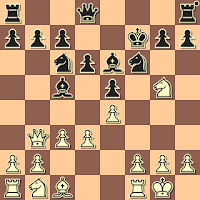White does not always win by direct attack in the Jerome Gambit (1.e4 e5 2.Nf3 Nc6 3.Bc4 Bc5 4.Bxf7+). Sometimes the pawns that he has in exchange for the sacrificed piece - the "Jerome pawns" - are a middle game and endgame factor that help bring home the full point.
The following game is a good example.
Wall, Bill - Guest1144561
Internet, 2021
1.e4 e5 2.Nf3 Nc6 3.Bc4 Bc5 4.Bxf7+
4...Kxf7 5. Nxe5+ Nxe5 6. Qh5+ Ng6
7.Qd5+ Ke8 8.Qxc5 d6 9.Qe3 Qe7
The Queens face off on the e-file. Black has a plan.
Black has the usual piece-for-two-pawns advantage that you see in the Jerome Gambit.
10.d3
Bill has also played 10.Nc3 Nf6 11.O-O Be6 12.f4 Ng4 13.Qg3 Bc4 14.d3 Qh4 15.Qxh4 Nxh4 16.dxc4 Kd7 17.f5 Ne5 18.Bg5 Nxc4 19.Bxh4 Nxb2 20.f6 g6 21.Rab1 Nc4 22.Rxb7 Ne3 23.Rfb1 Nxc2 24.Nd5 Nd4 25.Rxc7+ Ke6 26. Re7 checkmate, Wall,B - Guest3312852, PlayChess.com, 2012.
10...Nf6 11.Nc3
Also 11.O-O Ng4 12.Qe2 Nh4 13.Nc3 Be6 14.f4 g6 15.h3 Nh6 16.f5 N6xf5 17.exf5 gxf5 18.Re1 Kf7 19.Nd5 Qd7 20.Nxc7 Black resigned, Wall,B - Guest701131, PlayChess.com, 2019
11...d5 12.exd5
White does not mind exchanging Queens.
12...Qxe3+ 13.fxe3 Kf7
Black has a piece for a pawn. He plans to castle-by-hand.
14.O-O Re8 15.Nb5 Re7 16.e4 Kg8
This is a different kind of game from the usual smash and crash Jerome Gambit attack on the enemy King. It is useful to see how Bill continues.
17.Bg5 c6
Black attacks the pawn chain, while kicking the Knight - which will move, all in good time.
18.Bxf6 gxf6 19.d6 Rf7 20.Nc7 Rb8
The Knight always seems to be misplaced, but, somehow, always in the right place.
21.d4 Kg7
This is a tactical slip. Black could make plans to deal with the advanced enemy Knight with 21...Nf8 22.Rf2 Bd7 23.Raf1 Ne6 24.Nxe6 Bxe6 25.Rxf6 when White is at least comfortable and may have an edge.
22.Ne8+ Kf8 23.Nxf6 Kg7
The "Jerome pawns" are beginning to look ominous. Black's defense will include blockading the pawns, and, at the right time, returning the piece for 2 or 3 of them.
24.Nh5+ Kg8 25 e5 Rxf1+ 26.Rxf1
26...Bg4
A tactical slip that ends the game.
Stockfish 13 looks at the game this way: 26...Be6 27.b3 Rd8 28.c4 Bc8 29.Rf6 Nf8 30.d5 cxd5 31.cxd5 Re8 32.e6 Bxe6 33.dxe6 Rxe6 34.Rxe6 Nxe6 35.Nf6+ Kf7 36.Ne4 Nd8 37.Kf2 Ke6 38.g4 Nf7 39.Kf3 Nxd6 40.Ng5+ Ke5 41.Nxh7 White's central pawns have all disappeared, but his connected passed pawns on the Kingside will win the game.
27.Nf6+ Black resigned

























